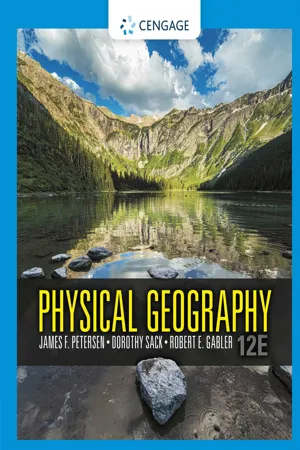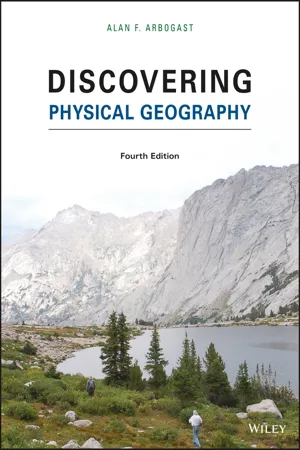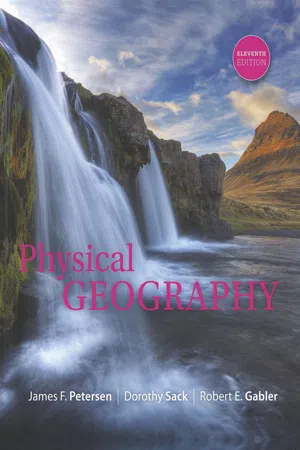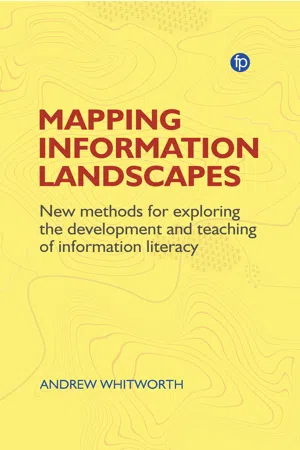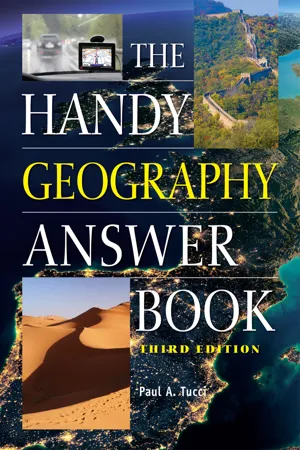Geography
Reference Maps
Reference maps are used to show the location and names of geographic features, such as cities, roads, and physical landmarks. They provide a visual representation of the Earth's surface and are often used for navigation, planning, and understanding spatial relationships. These maps typically include a legend or key to help users interpret the symbols and colors used to represent different features.
Written by Perlego with AI-assistance
Related key terms
1 of 5
8 Key excerpts on "Reference Maps"
- eBook - PDF
- James Petersen, Dorothy Sack, Robert Gabler, , James Petersen, James Petersen, Dorothy Sack, Robert Gabler(Authors)
- 2021(Publication Date)
- Cengage Learning EMEA(Publisher)
Cartographers can now gather spatial data and make maps faster than ever before—within hours—and the accuracy of these maps is excellent. Moreover, digital mapping enables mapmakers to experiment with a map’s basic characteristics (for example, scale or projections), to combine and manipulate map data, to transmit entire maps electronically, and to produce unique maps on demand. —Exploring Maps, United States Geological Survey (USGS) There are many kinds of maps, each designed to meet a cer- tain geographic function and to present spatial information about either broad or specific topics. There are two fundamental categories of maps, although the distinction is not always strict because of the large variety of map types and the many reasons for why maps are created. Reference Maps help us find general spatial information and locations to understand some basic rela- tionships. Examples include political maps, which show coun- tries, states, towns, and cities; and physical maps, which show mountains, rivers, plains, and water bodies. Reference Maps are common in world atlases and as classroom wall maps. Reference Maps are designed to display a broad spectrum of geographic information. Thematic maps focus attention on a specific char- acteristic, topic, or set of related features. Examples of thematic ● FIGURE 2.1 This clay tablet preserves an ancient map from Mesopotamia, located in today’s Iraq. Estimated to be 3500 years old, it is thought to be the world’s oldest map of a city. Z1009/_Jan-Peter Kasper/dpa/picture-alliance/Newscom Copyright 2022 Cengage Learning. All Rights Reserved. May not be copied, scanned, or duplicated, in whole or in part. Due to electronic rights, some third party content may be suppressed from the eBook and/or eChapter(s). Editorial review has deemed that any suppressed content does not materially affect the overall learning experience. - eBook - PDF
- James Petersen, Dorothy Sack, Robert Gabler, , James Petersen, Dorothy Sack, Robert Gabler(Authors)
- 2014(Publication Date)
- Cengage Learning EMEA(Publisher)
Maps and Location on Earth Cartography is the science and profession of map making. Geographers who specialize in cartography design maps and globes to ensure that mapped information and data are accu-rate and effectively presented. The primary purpose of a map is spatial and locational communication. Maps, through graphic representations and symbols, are very efficient visual media for relaying a vast amount of information. Maps are :: Objectives When you complete this chapter you should be able to: ■ Explain the ways that Earth and its regions, places, and locations can be represented on a variety of visual media: maps, aerial photographs, and other imagery. ■ Assess the nature and importance of maps and maplike presentations of the planet or parts of Earth, citing some examples. ■ Find and describe the locations of places using coordinate systems, use topographic maps to find elevations, and understand the three types of map scales. ■ Demonstrate knowledge of techniques that support geographic inves-tigations, including mapping, spatial analysis, satellite and aerial photo interpretation, and computer analysis of geographic data. ■ Evaluate the advantages and limitations of different kinds of represen-tations of Earth and its areas. ■ Understand how the proper techniques, images, and maps can be used to best advantage in solving geographic problems. ■ Recognize the benefits of spatial technologies such as geographic in-formation systems (GIS), the Global Positioning System (GPS), and re-mote sensing. Copyright 2013 Cengage Learning. All Rights Reserved. May not be copied, scanned, or duplicated, in whole or in part. Due to electronic rights, some third party content may be suppressed from the eBook and/or eChapter(s). Editorial review has deemed that any suppressed content does not materially affect the overall learning experience. Cengage Learning reserves the right to remove additional content at any time if subsequent rights restrictions require it. - eBook - PDF
- Alan F. Arbogast(Author)
- 2017(Publication Date)
- Wiley(Publisher)
Most everyone knows that the primary tool associated with geography is the map. Figure 2.10 shows a typical thematic map (it focuses on a specific theme) and is one with which you are probably familiar. This map shows the United States and includes such geographic information as state boundaries, location of major cities, the course of major rivers, and vegetation patterns. You probably also know that a map such as this one contains a scale, a compass arrow pointing north, and a legend that defines major categories within the map, such as population density, the area covered by cities, the relative size of high- ways, or the location of mountain ranges. A wide variety of additional information can be portrayed on maps, including the geographic distribution and thickness of rock units, tem- perature, precipitation patterns, intensity of solar radiation, vegetation, and soils. Much of the information in this text is presented in map form, so in order to navigate through this book and to be successful in your course, it is helpful to under- stand the fundamentals of cartography. Cartography is the subdiscipline of geography that focuses on the many ways to display spatial information so that it can be used and understood efficiently. The essence of cartography is the manner in which Earth is portrayed in a usable fashion. This task can be accomplished in a variety of ways. The most visually accurate and complete way to illus- trate the entire Earth is through the use of a globe (Figure 2.11), which depicts locations on the three-dimensional representa- tion of the planet. Globes can be cumbersome to use, however, and often do not illustrate the level of detail desired. Instead, geographers frequently rely on two-dimensional maps to show various geographic locations and attributes. Many factors must be taken into consideration to represent these features most accurately. - No longer available |Learn more
- James Petersen, Dorothy Sack, Robert Gabler(Authors)
- 2016(Publication Date)
- Cengage Learning EMEA(Publisher)
Geographers use these technologies to help them understand environmental concerns and to facilitate spatial problem solving. They also work to improve methods for mapping, analyzing, and displaying spatial information. Because maps are so widely used as a form of visual communication, it is important to be able to read and interpret them correctly. An informed knowledge of spatial representation and the ability to effectively communicate locational information is useful in our daily lives and is essential in the study of physical geography. Maps and Location on Earth Cartography is the science and profession of mapmaking. Geographers who specialize in cartography design maps and globes to ensure that mapped information and data are accurate and effectively presented. The purpose of a map is to communicate spatial and locational information. Maps, through graphic repre- sentations and symbols, “a language of location,” are very efficient visual media that can relay a vast amount of information in a short amount of time. Maps are an essential resource for navigation, community planning, surveying, history, meteorology, geology, political science, and many other career fields. On television, on the Internet, and in weather reports, maps contribute to our understanding of current events. Think of all the places where you encounter maps. In travel, recreation, education, the media, enter- tainment, and business, maps communicate important information. Computer tecology has revolutionized cartography and digital imagery. Maps that once had to be hand drawn (● Fig. 2.2) are now produced digitally and can be displayed or printed in a short time. Computer-assisted mapping allows easy revision, which was a time-consuming process when maps were hand drawn. Information that was once gathered little by little from ground observations and field surveys can now be collected instantly by satellites that flash recorded data back to Earth at the speed of light. - eBook - PDF
- Joseph P. Stoltman(Author)
- 2011(Publication Date)
- SAGE Publications, Inc(Publisher)
61 CARTOGRAPHY JANET S. SMITH Shippensburg University JEFFREY S. TORGUSON St. Cloud State University Introduction Maps are essential to the discipline of geography because they constitute the language with which all geographers communicate. Regardless of area of specialty, from geo- morphology to political ecology, from social theorist to meteorologist, maps serve as the element that unifies the discipline of geography. With maps, geographers depict locations and display spatial relationships and spatial dis- tributions; additionally, maps are tools, which allow geog- raphers to visualize and hypothesize spatial connections because many spatial relationships are not visible until they are plotted on a map. Cartography has a long and interesting history filled with revolutionary changes that have altered the creation and production of maps. Ubiquitous Maps It is impossible to imagine life in the 21st century with- out maps. Maps are everywhere; they are presented with the daily weather forecast, accompany GPS navigational sys- tems in vehicles, constitute a focal point in advertisements, and point consumers toward retail locations in malls. Maps are frequently featured in newspapers and magazines as well; they are prominent on millions of websites. Although these maps may differ in design from those that accompany academic research or textbooks, the common presence of maps in everyday life indicates the vital role that maps play in communicating spatial relationships at all levels of human culture. The recognition of the importance of maps is not new; however, the sheer volume of maps is a more recent phenomenon attributable to greater access to data, computer mapping programs, and Internet-mapping appli- cations. The ubiquitous nature of maps at the beginning of the 21st century indicatesjust how cartography has changed. - eBook - PDF
- Stephen Scoffham(Author)
- 2016(Publication Date)
- Routledge(Publisher)
As one child with learning difficulties commented when doing this sort of work while he learned geography without realising it: ‘I can do pictures!’ STARTING WITH MAPS Maps are informative and useful but they can also be wonderful works of art in their own right. Their essence and purpose is to represent a three-dimensional world in a two-dimen- sional format to communicate spatial information. Maps tell a story. Spatial thinkers are fascinated by this, but linear or sequential thinkers can find it challenging. Maps, and also diagrams, tell a story that is represented, essentially, pictorially. Children need to be taught to read this pictorial story in much the same way as they are taught to read word stories. The term ‘visual literacy’ or, in a geographical sense, the word ‘graphicacy’ is often used to describe these skills. There are many different types, styles, perspectives and scales of maps, but in this section there is only room for a few carto- graphic styles, each fascinating in its own way, to be suggested as starting points. The message is to use as wide a range as you can. It is easy to make people feel that maps are incomprehensible, and even to alienate them from maps for life. One explanation is that maps per se, and especially Ordnance Survey maps with their conventions, are sometimes taught to children too soon and in isolation rather than in a relevant context. Although some youngsters are able to complete the tasks associated with OS maps, their understanding is often limited. This negativity can be easily overcome by devising activities to foster and encourage children’s innate love of, fascination for and curiosity about maps, especially if maps are used in associa- tion with other pictorial representations of places, spaces and environments. Historical maps fascinate children both in content and style. The Hereford Mappa Mundi was drawn on vellum (calf skin) in about 1290 and is one of the cathedral’s treas- ures. - eBook - PDF
Mapping Information Landscapes
New Methods for Exploring the Development and Teaching of Information Literacy
- Andrew Whitworth(Author)
- 2020(Publication Date)
- Facet Publishing(Publisher)
(Jacob, 1999, 25) How, then, do maps work? How do they represent the world in ways that make their mappings intelligible, even to those users who may never have visited the landscape being depicted? MAPS AND MAPPING 27 28 MAPPING INFORMATION LANDSCAPES Mapping space and place Mapping can be a scientific, objective practice, a personal, subjective practice, and a social, intersubjective one. Each realm of knowledge is integrated into any map and its use. Understanding the difference between them is important for establishing the distinction between place and space that is essential to an understanding of how mapping plays different and sometimes contradictory roles in representing and shaping the world. Cartography as a technical practice depends on the development of systems of representation. For example, modern ‘Western’ cartography was significantly defined by Mercator’s projection, first published in 1569. With some adjustments to correct distortions in the sizes of polar lands, it is still familiar today. Lines of latitude and longitude, and other co-ordinate systems like the UK’s National Grid, are widespread and familiar ways of creating a data ‘net’ into which observations about the world can be slotted and thereby made quantitative and generalisable. Conventions are employed, for example the typical placing of north at the top of the map. These levels of abstraction and informational transformation mean that a map of somewhere one has never been remains intelligible and useful in navigation. A map is thus ‘more than an imaginative picture’ (Cosgrove, 2008, 168). Rather: Numbers, lines, colours and key coding reinforce the thematic map’s scientific status as an ‘immutable mobile’, to borrow the philosopher of science Bruno Latour’s term for an instrument that preserves the meaning and truth claims of scientific observations as they circulate across space and time. - eBook - PDF
- Paul A Tucci(Author)
- 2016(Publication Date)
- Visible Ink Press(Publisher)
Though gazetteers are readily accessible, they don’t include as many places as online databases. There are a number of sites on the Internet that have extensive databases of latitude and longitude and even include such specific places as public buildings. What is the difference between a physical map and a political map? A physical map shows natural features of the land such as mountains, rivers, lakes, streams, and deserts. A political map shows human-made features and boundaries such as cities, highways, and countries. The maps we use in atlases and see on the walls of classrooms are typically a combination of the two. What is a topographic map? A topographic map shows human and physical features of the Earth and can be distinguished from other maps by its great detail and by its contour lines indicating elevation. Topographic maps are excellent sources of detailed information about a very small area of the Earth. The United States Geological Survey (USGS) produces a set of topographic maps for the United States that are at a scale of 1:24,000 (one inch equaling 2,000 feet [or 1 centimeter equaling about 240 km]). You can purchase these maps online, at sporting goods stores, or through the USGS itself. Why are road maps so difficult to fold? The problem lies with the multitude of folds required to return the map to its original, folded shape. The easiest way to fold a road map is to study the creases and to fold the map in the order that the creases will allow. But once you’ve made a mistake, the folds have lost their telltale instructions. To fold a road map, begin by folding it accordion style, making sure that the “front” and “back” of the folded design appear on top. Then, once the entire map is folded accordion style, fold the remaining slim, long, folded paper into three sections. And, voilà, your road map is folded! Why is color important on a relief map? A relief map portrays various elevations in different colors.
Index pages curate the most relevant extracts from our library of academic textbooks. They’ve been created using an in-house natural language model (NLM), each adding context and meaning to key research topics.
